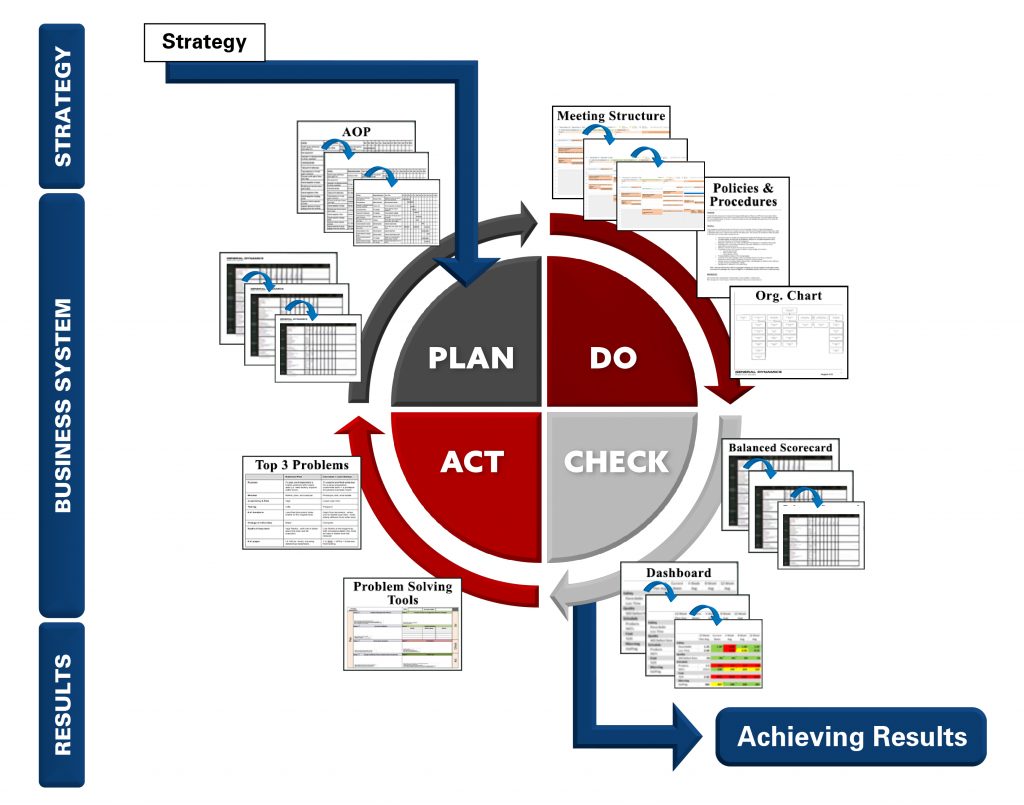[Post by Chuck Krugh, January 27, 2023]
One area that I haven’t yet discussed in depth is the cascading nature of the Business Operating System (BOS). One of the strengths of the system is that information moves, or cascades, both down and up in the company, depicted by the blue arched arrows in the model. Information flow is critical to the success of the system and to our company.

Our ability to hit our targets is vital to our success. To hit the targets, all of us in the company need to understand how we each, as individuals and as our unit, contribute to meeting them. If you don’t know what the target is, how can you ever hit it? Further, if you cannot see our progress toward the target, then you don’t know where we are and may not know what you need to do next. Alignment only comes after you understand your part in – and how you contribute to – executing the plan. As you gain awareness of and understand the overall plan, we will start to speak a common language about our performance in relation to our company goals.
So, how do we begin? As we talked about in previous blogs, the Senior Leadership Team or SLT, which is our eight vice presidents and me, creates the high-level strategy for the company. We develop this strategy in five-year increments, with the first year being granular and the last year being more directional than specific. The targets we set are – at a minimum – necessary to keep the company operating, but more importantly, should grow the company. We’ll talk more about strategy in a future blog.
Using the first year’s strategy, we create an Annual Operating Plan or AOP. The AOP is the document that begins the “translation” process from the strategy document into the different targets for each area and level of the company. This is a big step!
The “translation” process is how we break down the strategy into meaningful components for each level in the company. A goal within a high-level strategy by itself may speak to the members of the SLT who created it, but it won’t necessarily speak to a person on the deckplates. In fact, people on the deckplates or in an office may not see a direct connection to how they help the company meet that specific goal. The high-level goal needs to be broken down so that everyone understands how they impact the goal at each level. This is the process of “translation.”
Let’s look at an example. Let’s say that we want to have a goal of 100% on-time delivery for 2023. On the surface, it looks like the company wants to deliver ships 100% on time. It may be hard for a person on the deckplates to relate to this goal from an individual perspective. However, if we “translate” the goal for each level in the company, it might look like this for Production:
VP Level: Deliver ships or move units on schedule with no traveled work.
Director Level: Complete “ALL” 471 feeder units to meet schedule with no traveled work.
Manager Level: Complete 471 unit on schedule with no traveled work.
FLS Level: Complete the plan of the week for the subassemblies that feed the 471 unit.
Deckplate (point of execution): Complete the daily work plan that feeds the 471 units on time with no traveled work.
But what if you are an office-based employee in what is sometimes called a “support” function, how might it work for you? Let’s look at another example of 100% on-time delivery for 2023 in a support area – HR:
VP Level: Meet or beat hiring-cycle time target for 2023.
Director Level: Ensure all requisitions meet cycle-time target.
Manager Level: Fill “ALL” requisitions for assigned division(s) within cycle-time target.
Recruiter (point of execution): Fill “ALL” Engineering requisitions within cycle-time target.
As you can see, the “translation” of the goal cascades the high-level strategy from the SLT down through each level to the deckplates or the point of execution. Each one of the AOP goals should “translate.” That’s how we not only align with the company strategy, but also understand how we are contributing, both individually and together as a team, to hitting our targets.
But wait, there’s more… Once we have translated the company goals down to the point of execution, we then measure our success by starting at the lowest level. For example, beginning at the lowest level – the point of execution, if we make our daily work plan, then we’ve hit our goal. By making the lowest level goal, it automatically contributes to the next level up achieving their goal. It rolls up from there, and is tracked and communicated up to the next level and then the next.
Tracking our goal attainment at each level is how we measure our success and know how we are doing from the bottom to the top each day. Tracking this progress becomes part of our scorecard. It also tells us whether we are on track to achieve our goals, and as we Plan-Do-Check-Act, gives us an opportunity to make adjustments.
This example shows us how to cascade goals from top to bottom, how to translate goals from the high level to the point of execution and how this creates a scorecard we can use to track progress towards our goals.
Next time, we’ll build upon this aspect of our cascading Business Operating System (BOS) and talk about viz-boards.
See you on the deckplates!
Safely Execute High-Quality Work
Chuck
President, General Dynamics Bath Iron Works
Click here to view more From the Helm blog posts.
